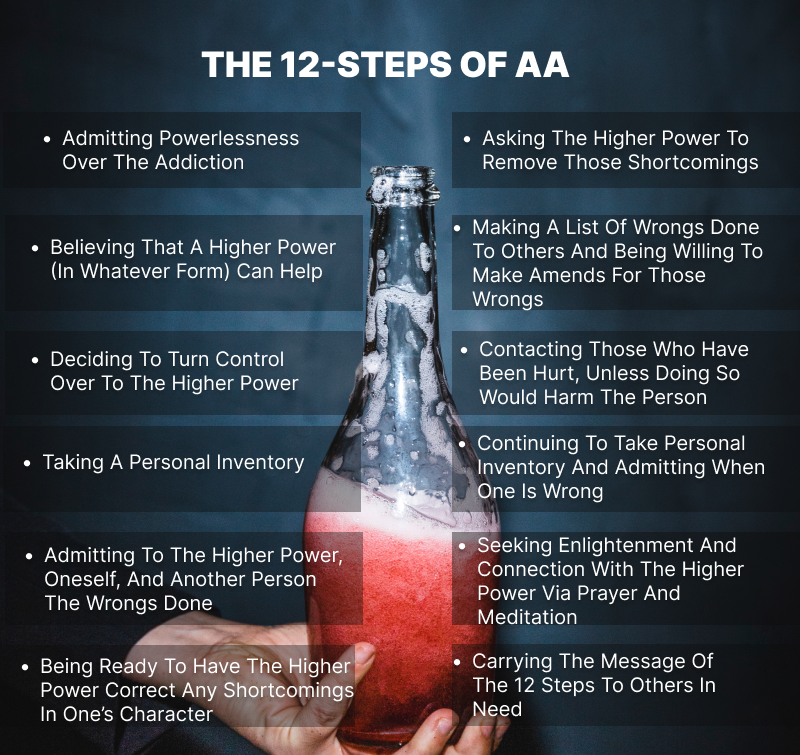Are you ready to take the first step towards a new life? The AA 12 steps are more than just a program. They are a journey towards freedom from addiction. It is organized by Alcoholics Anonymous, these twelve powerful steps have guided millions to regain control of their lives and from the grips of dependency. Whether you’re considering a 12 step program for yourself or a loved one, understanding these principles can be the first step towards a transformative journey.
In this article, we will understand how these steps work and why they might be the key to regaining control and finding lasting sobriety
12-STEP AA PROGRAM
The 12-Step AA Program is a set of steps created by Alcoholics Anonymous to help people stop drinking alcohol. It includes twelve actions that guide you on a journey of self-improvement and healing. These steps help you admit you can’t control your drinking, find support from a higher power, fix problems caused by drinking, and improve yourself. The AA 12 Steps are more than just quitting alcohol, But also they help you to change your life for the better and fix relationships with others. Millions of people around the world follow AA 12 steps to take back control of their lives and get better.
WHAT ARE THE 12-STEPS OF AA

The 12 steps of AA are given in the Big Book written by Bill Wilson and Dr. Robert Holbrook Smith in 1938.
- Admitting powerlessness over the addiction
- Believing that a higher power (in whatever form) can help
- Deciding to turn control over to the higher power
- Taking a personal inventory
- Admitting to the higher power, oneself, and another person the wrongs done
- Being ready to have the higher power correct any shortcomings in one’s character
- Asking the higher power to remove those shortcomings
- Making a list of wrongs done to others and being willing to make amends for those wrongs
- Contacting those who have been hurt, unless doing so would harm the person
- Continuing to take personal inventory and admitting when one is wrong
- Seeking enlightenment and connection with the higher power via prayer and meditation
- Carrying the message of the 12 Steps to others in need
HISTORY OF THE 12-STEPS OF AA
The 12-Step AA Program was established by Bill Wilson and Dr. Robert Holbrook Smith in 1938 in Akron, Ohio. Wilson wrote down ideas from his own experiences and visions of overcoming alcoholism, which eventually formed the basis of the program. He shared these ideas in a famous book known as the “Big Book.”
As the number of AA chapters grew during the 1930 and 1940s, the guiding principles, known as the Twelve Traditions, were gradually defined. Tradition Five emerged with a clear purpose. “Each group has but one primary purpose to carry its message to the alcoholic who still suffers”. This traditions underscores that those seeking recovery in AA must have a desire to stop drinking alcohol.
Today, with challenges like COVID-19 making it hard to meet in person, Alcoholics Anonymous has started offering Virtual Support Meetings. There’s also a private Facebook Group for ongoing virtual support, keeping everyone connected and supported during recovery.
The “Big Book” wasn’t just a guide; it became the foundation for the entire program. It was meant to help those who couldn’t get to AA meetings in person. Over time, this model has been adapted for other types of addiction support groups too, like Narcotics Anonymous and Gamblers Anonymous.
The principles of AA, encapsulated in the 12-Step AA program, have been adapted to form numerous other fellowship. Each of these fellowships is designed specifically for those recovering from various pathologies, emphasizing recovery from the specific malady which brought the individual into the fellowship.
This history of AA and its twelve-step program illustrates a journey of resilience and hope for those battling alcoholism.
Duration and Flexibility of the 12-Step Recovery Process
Are you curious about how long it takes to go through the 12 steps of Alcoholics Anonymous? Each person’s journey is unique, and there’s no set timeline for completing the AA 12 steps. It’s about personal growth at your own pace. Whether you’re starting out or already on the path.
Many 12-step sponsors encourage newcomers in AA and other 12-step programs to attend 90 meetings in 90 days and at least one meeting a day for three months. Overall, the focus of working through the 12 steps in any 12-step program shouldn’t be on the amount of time. It takes to get through the steps once, but on how thoroughly you are doing your step work and how you are using the steps to positively impact your everyday life.
Determining the Right Time to Join a 12-Step AA Program
You may need a 12-step program if you suffer from an SUD or qualify for having substance abuse issues of any kind. If you’re wondering whether a 12-step program is right for you, discuss this with your therapist, doctor, or other medical professional. They might have better insight as to whether a 12-step program could help you. At the very least, you can try to attend a free 12-step meeting on your own to see if it could be the right fit. Make sure not to make your decision off of one meeting, however, because every meeting is a bit different and some might fit your personality and goals better than others.
Final thoughts
The 12-Step Program provides a solid framework for addiction recovery. It guides individuals through a transformative journey of self-discovery and healing. Each step is made to help you to control and build a healthier future. With millions of success stories worldwide, these steps offer more than recovery.They promise a new way of life. If you are battling addiction, consider this program as a pathway to renewal. The road to recovery starts with a single step. Take that step today and begin your journey towards a life of freedom and fulfillment. Remember, support is just a step away.







